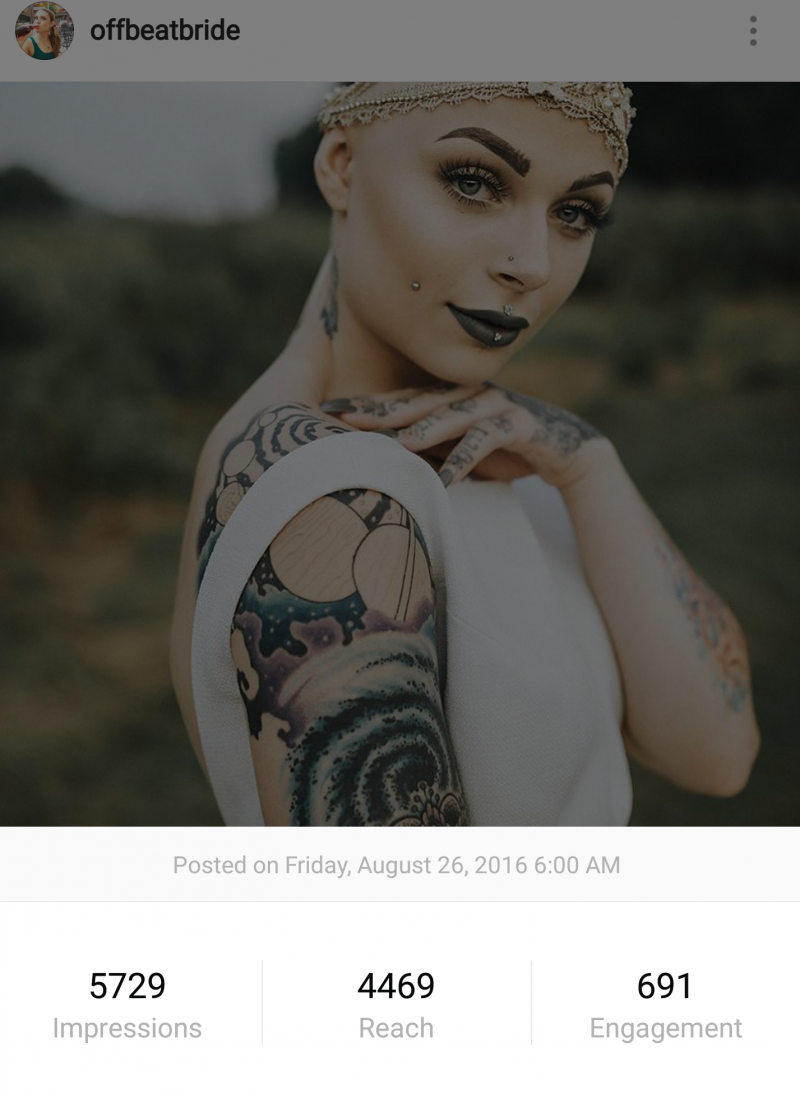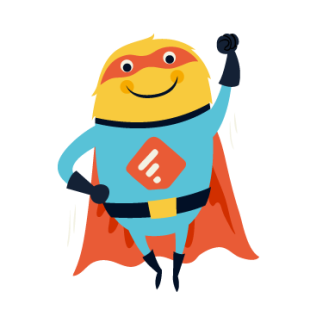
As a publisher, it’s been fascinating for me to watch the shifts in where and how Offbeat Bride reaches its readers. When Pinterest launched, suddenly a huge portion of our traffic started coming in from a brand new channel that simply hadn’t existed the previous year. As more and more people have shifted from using desktop computers to mobile phones, we watched mobile traffic from Facebook rise steeply — especially in the evenings, when folks are home watching TV browsing their Facebook feeds during ads.
This past year, I’ve been fascinated by the growing influence of Instagram. Of course Offbeat Bride has been on Instagram for years, but it’s always been a relatively small following — we’re talking 17k Instagram followers as compared to 155k on Facebook.
What’s interesting about those 17k followers is that they’re super duper engaged. Not in the wedding sense (although that too) but in the “interacting with our content” sense. An average post on Facebook might reach 10k people out of our 155k followers. A recent post on Instagram had a reach of 4.5k out of 17k followers. Let’s compare reach here — on Facebook we reach roughly 5% of our followers with an average post. On Instagram, we can reach 25% of our followers with a single post. THAT IS FUCKING POWERFUL!
Of course I could always pay to boost our posts on Facebook to reach more of our followers. That is absolutely an acceptable thing to do! I have some measure of pride, however, about how Offbeat Bride’s traffic is organic. All of it! Always has been! That’s just how I do business. I like to believe that consistently producing quality content results in traffic. It doesn’t really work that way any more, sometimes… but I am stubborn. Consistent quality content matters! Hurrumph!
There have been times when the shifts in social media has been depressing for me — we regularly get messages from followers on Facebook who say things that make it clear that they’ve never consciously visited the website, or know how to use its search function. They don’t really know there is an offbeatbride.com.
For these folks (which I’d guess is tens of thousands of people!) their experience of Offbeat Bride is strictly within the blue walls of Facebook. They follow our page, maybe they see content when the algorithm serves it up in their feed, they click the content if it’s interesting, the content is then renders it within Facebook’s built-in browser, they read the content on Facebook, and then they go back to browsing Facebook. They sometimes write and say things like “I’m so glad your page exists — it’s my favorite wedding thing on Facebook!” and and I cringe — I’ve spent a decade building this website! It’s a website! Not a page!
The same is true of Instagram. I see a lot of comments that are like “@madisonjayne You should totally follow this insta!” But… we’re… a website? DOES ANYONE EVEN KNOW WHAT A WEBSITE IS? And then I cry into my dedicated server and self-hosted WordPress install and feel like a dinosaur. (A side note: leave it to me to be crying over Offbeat Bride’s 1.6 million monthly pageviews — the reach of offbeatbride.com is fucking enormous! I just get emo when I feel like folks on social media don’t even know it’s there.)
As the years march on, however, and I watch content shift increasingly to third-party social media platforms, I’ve stopped fighting it. Save those tears for bigger problems. People want to interact with Offbeat Bride on Instagram instead of their web browser? Rad! Let’s post more photos on Instagram!
This is yet another example of something I first wrote about almost five years ago in a post called Changing your tools to meet your online community’s needs.
If I’ve learned anything from a decade of online community management, it’s that you cannot teach people how to use your community “correctly.” Your members will use the tools you make available the ways that suit them, and time spent trying to convince them to use them differently is just a waste of moderator energy. Your tools MUST match the needs of your community — if your members are not using the tools the way you intended, then you need to reassess the tool.
This is just the social media content management version of that concept — trying to convince readers that they should visit a website instead of browsing Facebook or Instagram is an epic waste of time. I mean, I’ve always thought RSS was awesome, but I stopped promoting it as something my readers should use years ago because, you know what? NO ONE USED IT. You gotta go where your readers are.
Here in 2016, it’s become clear that my readers are on Instagram… and you know what? I understand why! I’m on Instagram all day, because I love it! Instagram Stories are my new favorite toy! So why not invest in Instagram as a content management system? We still publish three posts a day, five days a week on offbeatbride.com — but now I post at least once a day on Instagram, too.
It should go without saying that, from a business strategy level, we’re also investing heavily in exploring Instagram as a revenue driver. If you’re a business who wants to learn more about that, you should totally email Tiffany. She’d loooove to talk to you about it.



I <3 RSS readers! I'm pretty sure I learned about them form you when I was engaged and planning my wedding 8-9 years ago and sticking to OBB and other sites that only feature real brides and not models at fake weddings or only million dollar weddings, or all those other things about WIC advertising that make me slightly uneasy and disenfranchised. I still mourn the loss of Google Reader but am VERY slowly adapting to Feedly (I know, I'm really slow).
RSS 4 Lyfe
I still use it too (FeedlyPro user here!) … But even I use it less than I used to, and I stopped trying to convince other people to use it a few years ago.
Feedly FTW.
RIP google reader. (Or better yet, be resurrected.)
That concept you talk about in the linked post is actually surprisingly broadly applicable; I’ve been thinking about it as it relates to tabletop RPGs recently, after watching a writer for one of the ones I like lecture people on how wrong they are for wanting to do X with his system instead of Y. I think it works for basically anything that’s creating stuff for other people to use – running a website, writing RPGs, even building physical objects. If you’re making something for a consumer audience, no matter what you’re making or what your consumer audience is, it’s important to keep track of what your consumers actually want to do with it and to make a product that does that well. In your case, these days people want something that can easily go into the Instagram/Facebook format of “ooh pretty, now where are my cat pictures?”, so you’re providing that. I imagine that’s why Offbeat Bride has been running for ten years and is on track for more.
This is a great point — that part of being a smart consumer-facing business owner is taking cues from your audience. My audience doesn’t care that my business model was originally built selling Product1 on X. Now they want Product1 on Y. Why would I try to convince them that they want something else? That’s fucking stupid. Better to pivot and provide Product1 where the people are asking for it… I mean, what a great problem to have!
People WANT Product1! There are companies begging for customers to want their product… I already have a market that wants it, they just want it on Y instead of X. So fuggit! Give the people what they want, and shift my business model accordingly!
Great post! I’m still learning the ins and outs of social media engagement since launching my blog. It’s easy to see how content management can become a full time job.
I may just have to email Tiffany!
I feel like, as a reader, that having a solid website is helping you transition from platform to platform. That core audience of people who *do* know your website can be the base for transitioning to new online platforms. Like imagine you were just a facebook page, how would you get your readers from facebook to instagram? You would would be super vulnerable to the effects of new facebook policies with no power to change them, and you would probably be affected by the current drop in content sharing on facebook. But this way you can move from platform to platform with your audience with the website as a base. One day the social media landscape might settle more but right now, despite the fact that it looked like facebook “won” for a while, things are a bit in flux.
You’re right that there’s a value to having a website as a home base for your third-party social media platforms. In many ways, a .com anchors the brand… it becomes a true “home page,” with each social media platform acting as a separate channel/expression of the brand.
That said, plenty of folks build their brands on multiple third-party platforms simultaneously, and then just shift their attention to channels as things grow. For instance, if Offbeat Bride was just a Facebook page, we’d be promoting our Instagram presence on Facebook.
I know a lot of YouTubers debate this issue a lot… they built their brands on the platform, and then when the platform messes with them via changes to algorithms or ad policies, their hands are tied. The same is true of Vine. That said, a few folks have been able to find some pretty significant reach via single platforms… it’s remarkable to see.